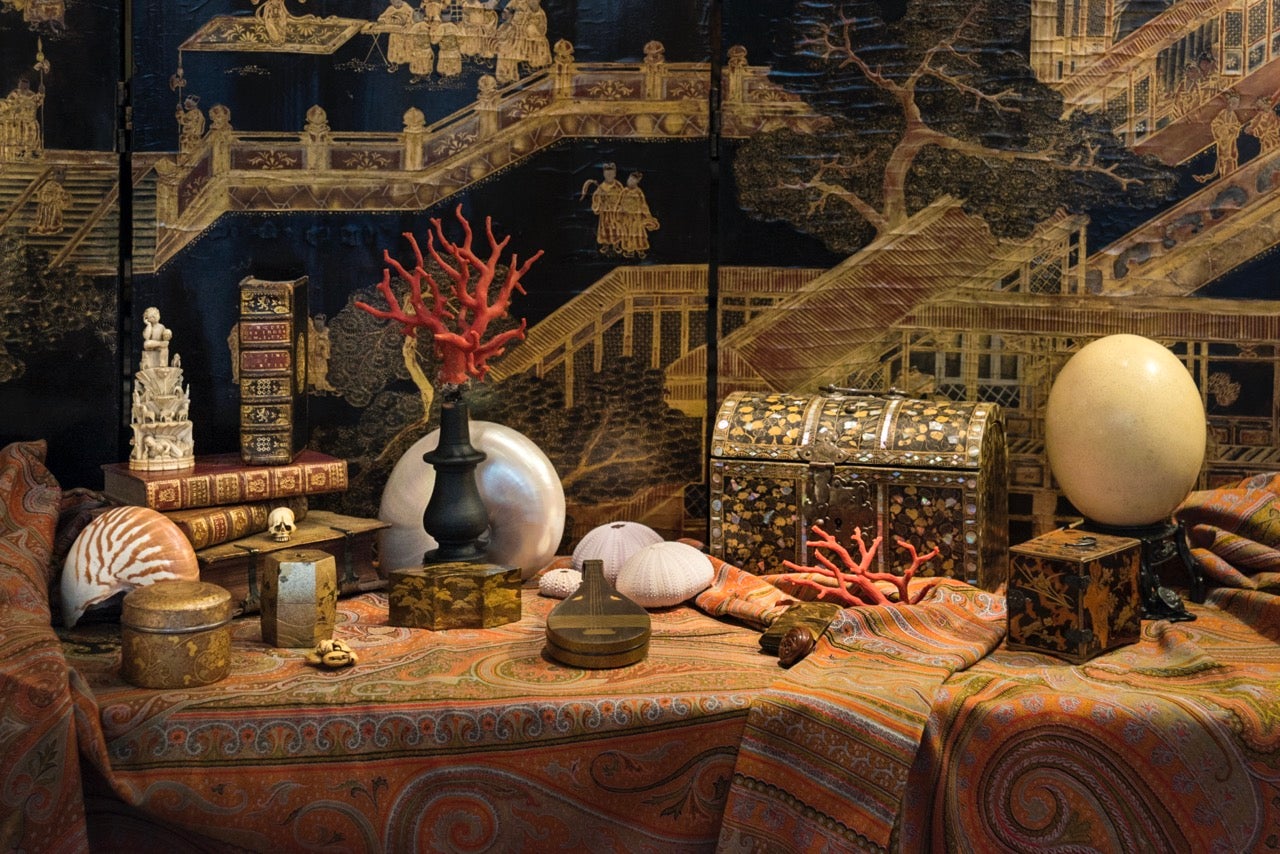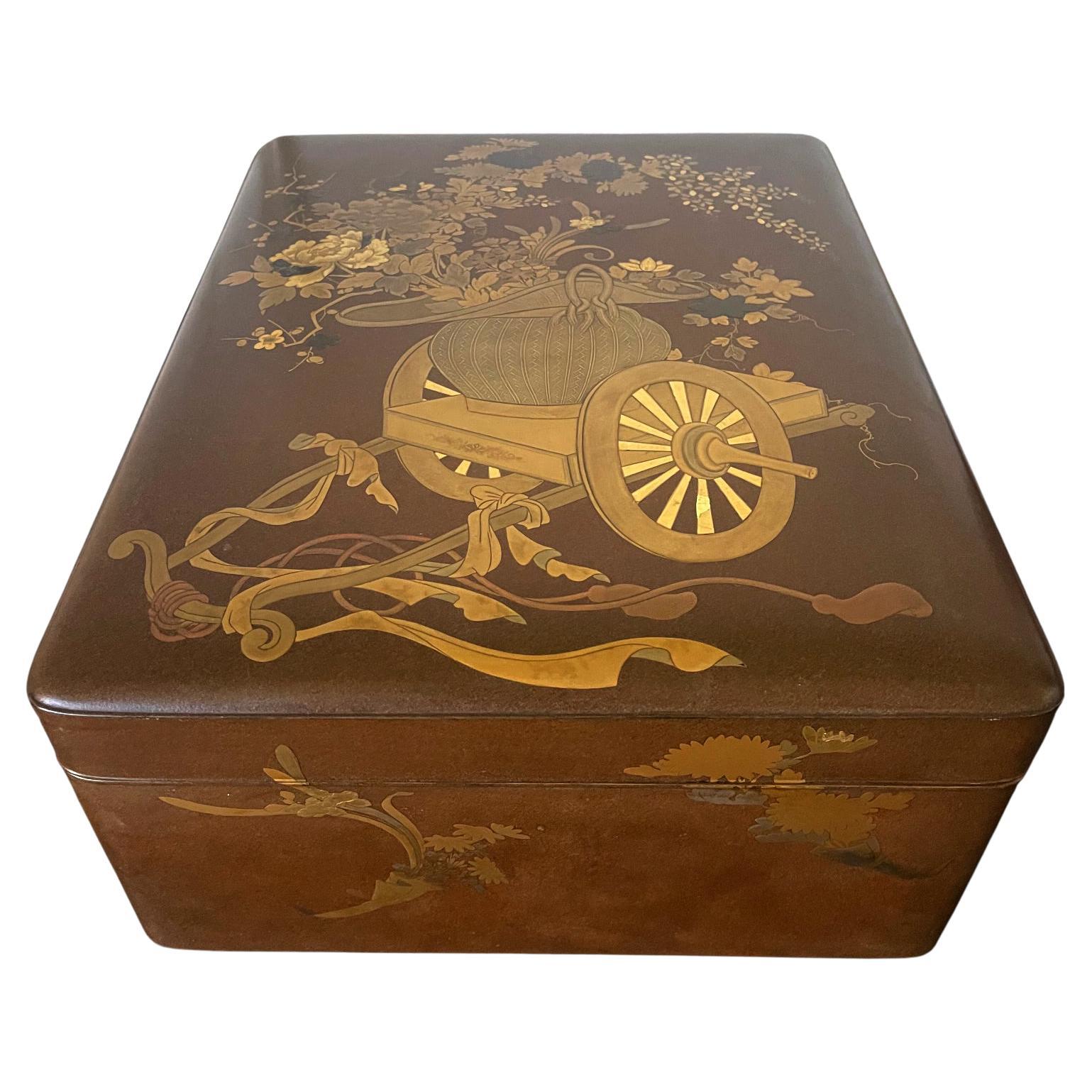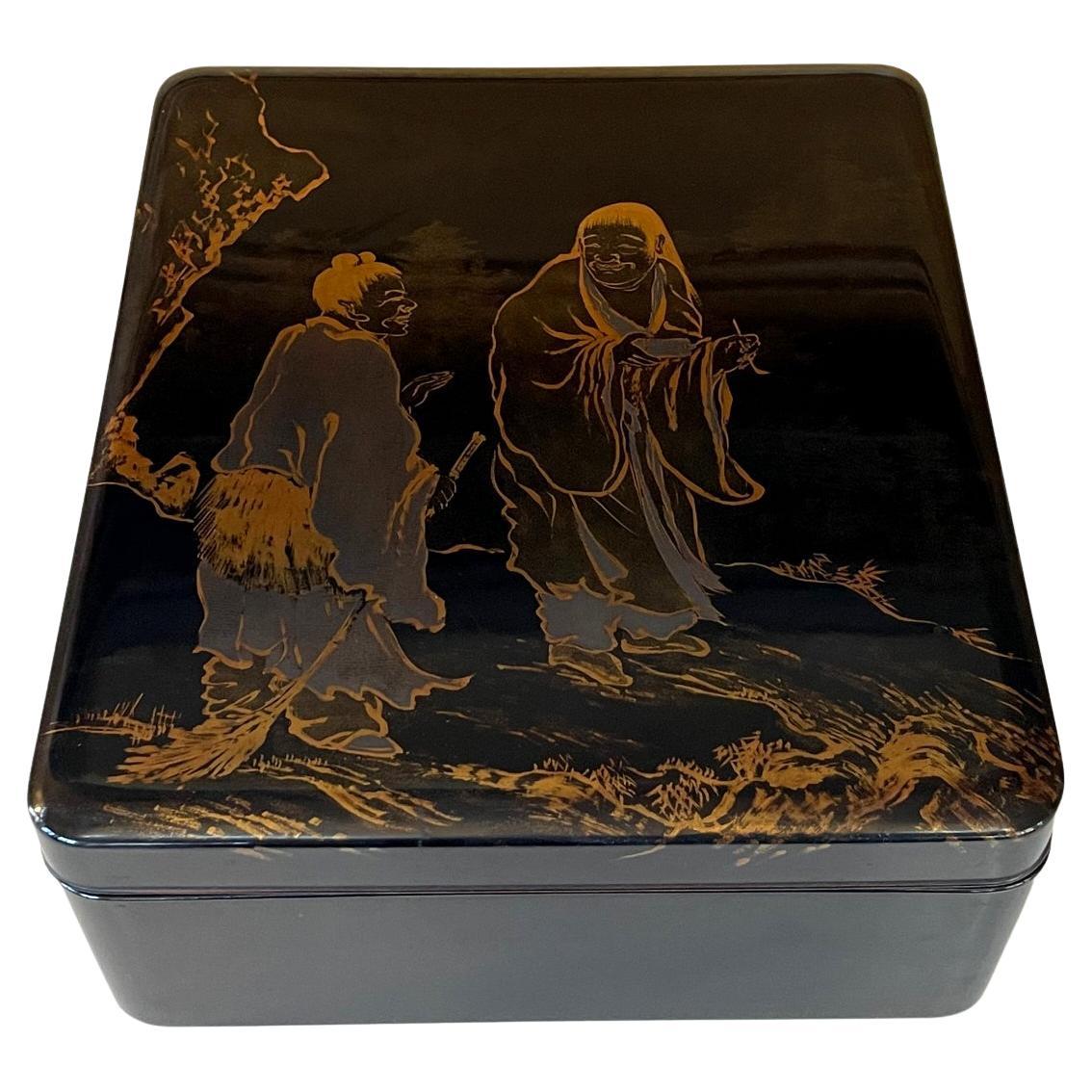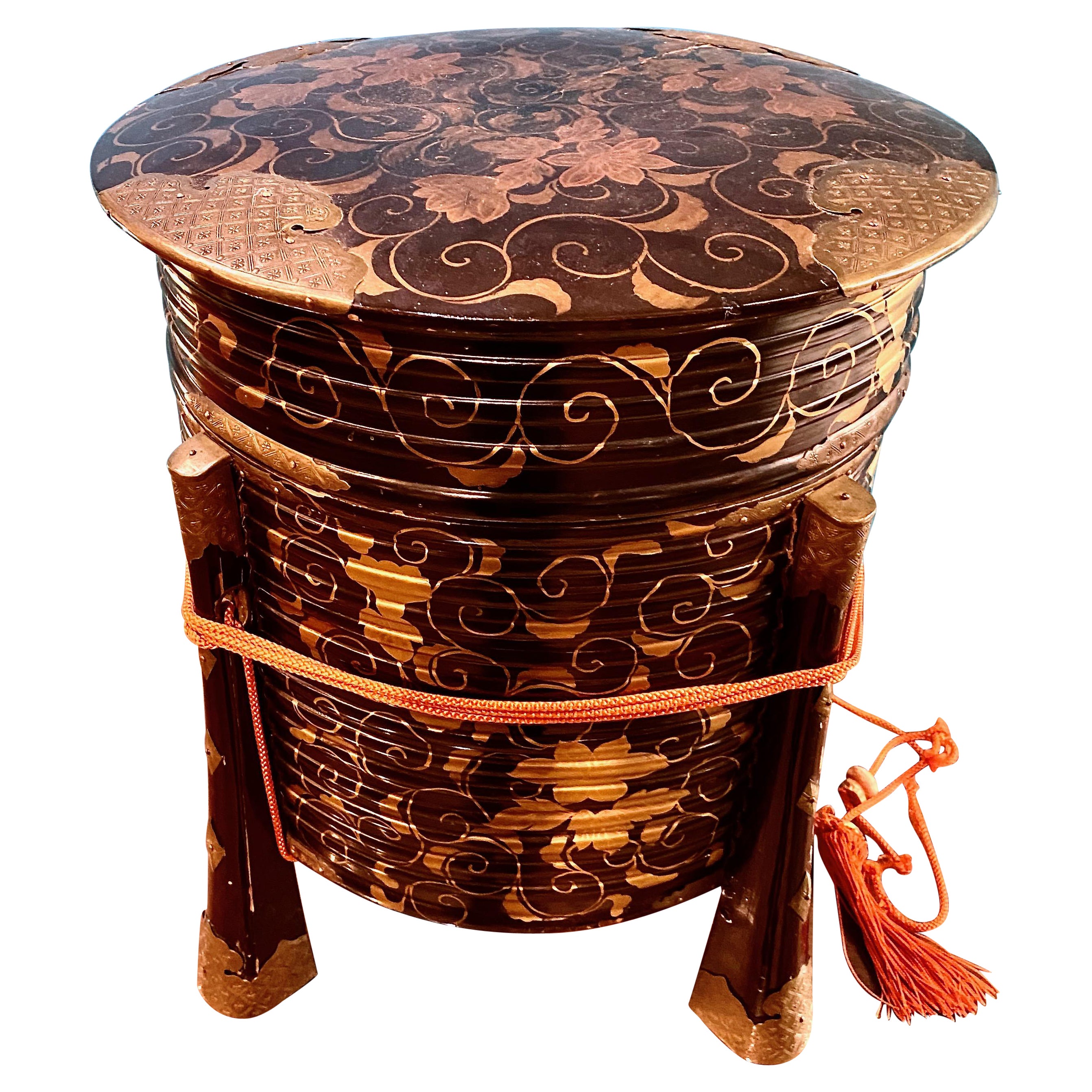Items Similar to Japan deer ryoshibako box Showa era Kawachi Hisaya
Want more images or videos?
Request additional images or videos from the seller
1 of 8
Japan deer ryoshibako box Showa era Kawachi Hisaya
About the Item
Cedar wooden ryoshibako (or bunko) document box, decorated with deer and crane on the outer lid and bat on the inner lid in takamaki-e lacquer. As a wedding box, these animals are symbols of happiness, longevity and good luck.
Kawachi Hisaya seal lower right.
Includes its transport box with inscriptions: "(...) / made by Kawachi Hisaya" (高[閑 ?]市/河内瓢也造).
Japan, Kawachi Hisaya – Showa era (1926-1989)
Height: 3.9 in (10 cm) – width: 10.2 in (26.2 cm) – depth: 13.8 in (35.5 cm)
- Dimensions:Height: 3.94 in (10 cm)Width: 10.32 in (26.2 cm)Depth: 13.98 in (35.5 cm)
- Style:Japonisme (In the Style Of)
- Materials and Techniques:
- Place of Origin:
- Period:
- Date of Manufacture:circa 1926-1989
- Condition:
- Seller Location:PARIS, FR
- Reference Number:

About the Seller
No Reviews Yet
Vetted Seller
These experienced sellers undergo a comprehensive evaluation by our team of in-house experts.
Established in 2013
1stDibs seller since 2023
- ShippingRetrieving quote...Ships From: PARIS, France
- Return PolicyA return for this item may be initiated within 7 days of delivery.
More From This SellerView All
- Japanese Lacquered Tebako 'Box'Located in PARIS, FRTebako box with three compartments in golden and nashi-ji lacquer, decorated with golden, red, and kirigane lacquer, golden persimmon tree leaves, among rocks. The compartments are of increasing size from the top. The decoration is in continuity. Persimmon has been cultivated in southern China for more than 2500 years and is believed to have been introduced to Japan in the 8th century. The veneer is a tree with very hard wood, similar to ebony. According to a legend, one specimen survived the atomic bombing of Nagasaki on August 9, 1945, close to the epicenter. It is therefore in Japan a symbol of strength and longevity. It is also the national fruit of the country. It is eaten as a traditional dish during New Year's Day celebrations. Tebako literally means "portable box...Category
Antique 1860s Japanese Lacquer
MaterialsLacquer
- Japanese Lacquered Furoshiki Kobako 'Box'Located in PARIS, FRRectangular and flat lacquer Kobako (small box) representing a furoshiki knot seen from above. Fundame background, furoshiki in takamaki-e with floral pattern, inside the folds of the fabric with black and gold sayagata pattern with togidashi maki-e technique. The saya (or sayagata) pattern is composed of Chinese swastikas...Category
Antique Late 19th Century Japanese Lacquer
MaterialsLacquer
- Japanese Lacquered Natsume 'Tea Box'Located in PARIS, FRNatsume in dark red lacquer, decorated with autumn leaves and cherry blossoms in hiramaki-e and nashiji. Interior in black lacquer. Maple leaves (Momiji) are celebrated in literatur...Category
Mid-20th Century Japanese Lacquer
MaterialsLacquer
- Japanese peony basket lacquered box EdoLocated in PARIS, FREight-sided, flared shaped lacquer kobako box, following the decoration on the lid depicting a basket of flowers, composed of peonies and chrysanthemums in gold takamaki-e and hirama...Category
Antique 18th Century Japanese Edo Lacquer
MaterialsGold
- Fine Japanese Lacquer Suzuribako 'Inkstone Box'Located in PARIS, FRBlack and gold maki-e and hirame-ji lacquer box representing a branch of plum tree in bloom which is entangled in a low wall, highlighted by mother-of-pearl inlay (raden). Inner cover made of nashi-ji lacquer with mizuhiki threads and folds. These are elements, made of silk and washi paper, supposed to bring luck and happiness, intended to seal envelopes on the specifics events (gift, new year, birth, marriage, death, etc.). Shape and color of the threads vary according to the occasion celebrated and the desired meaning. Interior in nashi-ji lacquer, with water cup...Category
Antique Late 19th Century Japanese Lacquer
MaterialsLacquer
- Japanese suzuribako lacquered box peony riverLocated in PARIS, FRSuzuribako box (empty) in black lacquer. Gold maki-e decoration of a river bordered by peonies, one with red highlights. The edges of the lid are in gold lacquer. Nashi-ji interior.Category
Antique Late 19th Century Japanese Lacquer
MaterialsGold
You May Also Like
- Japanese Lacquer Ryoshibako Document Box Meiji PeriodLocated in Atlanta, GAA large Japanese lacquer box with elaborate Maki-e design from Meiji period, (mid-late 19th century). The generous size of the box was reser...Category
Antique 19th Century Japanese Japonisme Lacquer
MaterialsWood, Lacquer
- Large Japanese Lacquer Document Box, Ryoshibako, Edo/Meiji period, JapanLocated in Austin, TXA large and magnificently decorated Japanese lacquer document box, ryoshibako, signed Umeboshi/Baikyo, late Edo or early Meiji Period, mid 19th century, Japan. The large document box, ryoshibako, of tall, rectangular shape with rounded corners, and fitted with an inrobuta (flush-fitting) cover with beveled edges. The exterior of this exquisite box is decorated all over with fifteen different raised reserves shaped as uchiwa (paddle) fans against a lush and intricate krikane ground imitating shagreen. The uchiwa shaped reserves all of takamaki-e, and exquisitely painted with designs of animals, flowers, and landscapes in silver, gold, maki-e, hiramaki-e, and takamaki-e, with kirikane, nashiji, and polychrome embellishments, upon gold lacquer fudame grounds. The interior of the lid is nothing short of spectacular, featuring a large design of a magnificent and beautifully detailed rooster and hen with chicks gathered around a lazy stream. Large stalks of chrysanthemum bloom behind them. All against an ethereal nashiji ground. The cover of the box features five reserves: 1. Three minogame (turtles with long tails), symbolizing longevity 2. "Narihira Crossing the Sumida" from The Tales of Ise...Category
Antique 1860s Japanese Meiji Lacquer
MaterialsSoftwood, Lacquer
- Japanese Lacquer Maki-E Tiered Suzuribako and RyoshibakoLocated in Atlanta, GAA Japanese roiro lacquer scholar combo box with an upper tier of inkstone box (Suzuribako) and a lower document box (Ryoshibako) circa 1910-30s (end of Meiji to Showa period). The high glossy box was beautifully decorated with an image of the famously eccentric Buddhist monks Hanshan and Shide (known in Japan as Kanzan and Jittoku). Often as a pair, they have been a popular motif in Japanese Zen painting...Category
Vintage 1920s Japanese Meiji Lacquer
MaterialsStone, Metal
- Japanese Showa Period Dry Lacquer Sculpture of a DuckLocated in Hudson, NYShowa Period (1926 - 1989) sculpture of a duck resting with its head tucked into its wings. Dry lacquer, or kanshitsu, is a process of layering and manipulating lacquer soaked cloth ...Category
Early 20th Century Japanese Showa Lacquer
MaterialsLacquer
- Japanese Maki-e Lacquer Stack Box JubakoLocated in Atlanta, GAAn antique jubako (stack boxes) with five tiers in an elongated octagon shape circa 19th century (end of Edo or beginning of Meiji period). jubako was traditionally used to store and...Category
Antique 19th Century Japanese Japonisme Lacquer
MaterialsWood, Lacquer
- Japanese Lacquer Hokai Box, 19th CenturyLocated in Pasadena, CAThis is a good example of a traditional Japanese Hokai shell storage box for the Kai-awase game. This box is well-detailed in chased brass appliques and makie. The box is in overall ...Category
Antique Late 19th Century Japanese Japonisme Lacquer
MaterialsWood, Lacquer





